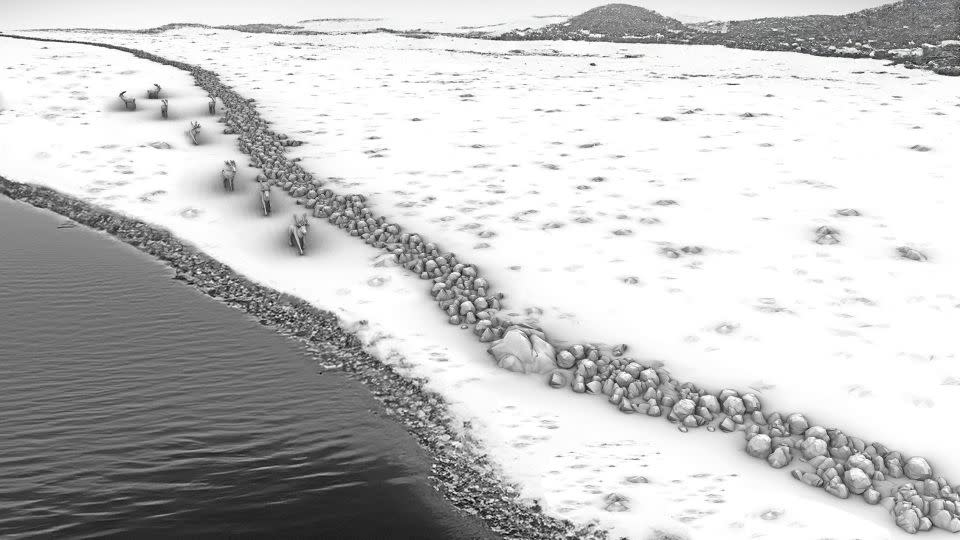Sign up for CNN’s Wonder Theory science newsletter. Explore the universe with news on exciting discoveries, scientific advances and more.
A megastructure found in the Baltic Sea may represent one of the oldest hunting structures used in the Stone Age — and could change what is known about how hunter-gatherers lived around 11,000 years ago.
Researchers and students from the University of Kiel in Germany came across the remarkable series of stones lying about 69 feet (21 meters) underwater during a marine geophysical survey along the seabed in Mecklenburg Bay, about 6 miles (9.7 kilometers) out from the coast of Rerik, Germany.
The discovery, made in the fall of 2021 while aboard the research vessel RV Alkor, revealed a wall made of 1,670 stones that stretched more than half a mile (1 kilometer). The stones, which joined several large boulders, were almost perfectly aligned, making it unlikely that nature shaped the structure.
After the researchers alerted the Mecklenburg-Vorpommern State Office for the Preservation of Culture and Monuments about their discovery, an investigation began to find out what the structure might be and how it ended up at the bottom Baltic Sea. Dive teams and an autonomous underwater vehicle were used to study the site.
The team determined that the wall was probably built by Stone Age communities to hunt reindeer over 10,000 years ago.
A study describing the structure was published Monday in the journal Proceedings of the National Academy of Sciences.
“Our investigations indicate that the stone wall is unlikely to have a natural underwater origin as well as construction in the modern era, for example in connection with the laying of submarine cables or stone quarrying. The methodical placement of the many small stones that connect the large immobile boulders speaks against this,” said lead study author Dr Jacob Geersen, senior scientist at the Leibniz Institute for Baltic Sea Research in Germany. in a statement.
Turning back time
The wall was probably built more than 10,000 years ago along the shores of lakes or bogs, according to the study. There were a lot of rocks in the area at the time, left behind by glaciers that had moved across the landscape.
But submerged structures are notoriously difficult to study and date, so the research team had to analyze how the region has evolved to determine the approximate age of the wall. They collected sediment samples, created a 3D model of the wall and virtually reconstructed the landscape where it was originally built.
Sea levels rose significantly after the end of the last ice age about 8,500 years ago, leaving the wall and large parts of the landscape under water, according to the study’s authors.
But things were different nearly 11,000 years ago.
“At this time, the total population across northern Europe was probably under 5,000 people. One of their main food sources was reindeer herds, which migrated seasonally through the sparsely vegetated post-glacial landscape,” said study co-author Dr. Marcel Bradtmöller, research assistant in prehistory and early history at the University of Rostock in Germany, in a statement. “The wall was probably used to guide the reindeer into a bottleneck between the shore of the nearby lake and the wall, or even into the lake, where Stone Age hunters could more easily kill them with their weapons.”

The hunter-gatherers used spears, bows and arrows to capture their prey, Bradtmöller said.
A secondary structure may have been used to create the clutter, but the research team has yet to find any evidence of it, Geersen said. However, it is likely that the hunters led the reindeer into the lake because the animals were slow swimmers, he said.
And the hunter-gatherer community seemed to recognize that the deer would follow the path created by the wall, the researchers said.
“The animals seem to be attracted by such linear structures and prefer to follow the structure instead of trying to cross it, even if it is only 0.5 meters (1.6 feet) high,” a Geersen said.
The discovery changes the way researchers think about highly mobile groups like hunter-gatherers, Bradtmöller said. Building a massive permanent structure like the wall suggests that these regional groups may be more focused on locations and territories than previously thought, he said.
Hunting sites around the world
The discovery represents the first Stone Age hunting structure in the Baltic region. But comparable prehistoric hunting structures can be found in other parts of the world, including the United States and Greenland, as well as Saudi Arabia and Jordan, where researchers have found traps known as “desert kites “.
Stone walls and hunting blinds previously built for hunting caribou were found at the bottom of Lake Huron in Michigan and were found at a depth of 98 feet (30 meters). The construction and location of the Lake Huron wall, which includes a lake shore on one side, is more similar to the walls of the Baltic Sea, the study authors said.
Meanwhile, the scientists continue their investigation in the Baltic Sea using sonar and sound devices, as well as planning future dives to search for archaeological finds. Such discoveries can only be made by combining expertise from those in fields such as marine geology, geophysics and archaeology, Geersen said.
Understanding the location of lost structures and artifacts on the seabed is critical as demand for offshore areas increases due to tourism and fishing and the construction of pipelines and wind farms, he said. And other undiscovered treasures at the bottom of the Baltic Sea could shed more light on ancient hunter-gatherer communities.
“We have evidence of comparable stone walls at other locations in (Mecklenburg Bay). These will also be systematically investigated,” study co-author Dr. Jens Schneider von Deimling, a researcher in the Marine Geophysics and Hydroacoustics group at the University of Kiel, said in a statement.
For more CNN news and newsletters create an account at CNN.com